American Samoa
Culture Name
American Samoan
Alternative Names
An early explorer, Louis de Bougainville called the Samoan islands the Navigator's Islands, and some early government reports may refer to American Samoa as Eastern Samoa.
Orientation
Location and Geography. American Samoa is part of the greater Samoan archipelago in the South Pacific half-way between Hawaii and New Zealand. The four western islands constitute the independent nation of Western Samoa (now "Samoa"). In American Samoa, an unincorporated territory only 76.1 square miles (197 square kilometers) in area, the largest island is Tutuila, the administrative center. Just offshore is Aunu'u, and sixty miles to the east is the Manu'a Group: Ofu, Olosega, and Ta'ū. The most remote parts are two atolls, Swain's Island and Rose Island.
The main islands are of volcanic origin, with low coastal areas, fringe reefs, and sand beaches where most villages are located. The land rises abruptly to highland ridges with mountain summits as high as 3000 feet. In this tropical climate, vegetation is dense, and mountain slopes are heavily wooded.
Demography. The population has been projected to be sixty-five thousand in the year 2000, a 69 percent increase since 1960. This population is 89 percent Samoan, 3.7 percent Tongan, and about 2 percent white (mostly Americans). The remaining 5 percent are small subgroups from other Pacific islands, Asians, and groups of mixed heritage. The increase in population since 1960 can be attributed to improved health care and sanitation, a high birthrate, reduced infant mortality, increased life expectancy, and immigration.
Linguistic Affiliation. The Samoan language is part of the Austronesian linguistic family. The Samoic subgroup includes Samoan and the languages of Tokelau and Tuvalu.
Samoan is spoken at home, but most residents also speak English. English is taught in schools from the early grades, and the 1990 census reported that fewer than a thousand people age five or older did not speak English.
Symbolism. Fa'aSamoa, "the Samoan way," encompasses attitudes, beliefs, and traditions that symbolize a world view, shared throughout the archipelago. It is their explanation of the appropriate way to live.
History and Ethnic Relations
Emergence of the Nation. The ancestors of present-day Samoans moved out of Southeast Asia and settled in islands just west of Samoa as early as 1500 B . C . E . They arrived on a double hulled sailing craft with domesticated plants (taro and yams), pigs, chickens, and dogs, as well as pottery known as lapita ware. By the first century A . D ., these people began moving into Samoa and Tonga.
Early contact between Europeans and Samoans occurred in 1722, when the Dutch navigator Jacob Roggeveen's ships called at Ta'ū, followed by French explorers in 1768 and in 1787. Charles Wilkes, commander of the United States Exploring Expedition, observed the culture in 1839 and established a permanent relationship with the Samoans. In the 1800s, Pago Pago's well-protected harbor was a popular port for American whaling ships.
In April 1899, a coaling station was built in Pago Pago harbor by the U. S. Navy, and in February 1900, a deed of cession was negotiated with Tutuila chiefs by Naval Commander B.F. Tilley. In
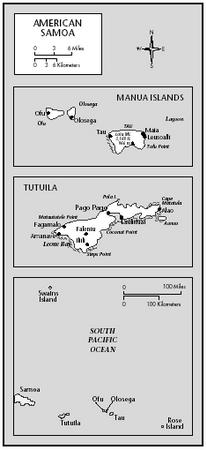
National Identity. U. S. Navy administration was never oppressive. Samoan customs were preserved if not in conflict with U.S. laws. Hereditary chiefs and talking chiefs were allowed to retain their own forms of assemblage to deal with local political affairs.
Naval officers served as governors until 1951, when the U. S. Department of the Interior assumed responsibility and governors were appointed by the President. Since 1978, governors have been elected by the Samoan people.
Native born American Samoans are U. S. nationals and are free to travel between the two countries and reside in either. Samoans take pride in their status as a U. S. territory and seem uninterested in independence.
Ethnic Relations. The American population has never been large, but Americans have held important positions in government agencies and the public school system. Some intermarriage has occurred, and Americans who become long-term residents tend to adapt to the Samoan way of life. Since 1951, there has been an increased flow of Samoan migrants to the United States, where they have established their own churches and often maintain a Samoan lifestyle.
Urbanism, Architecture, and the Use of Space
Until the twentieth century, the lifestyle was rural, and this remains the case in outlying islands and most villages outside Pago Pago Bay. Urban development around the bay and near the airport has a small-town quality.
Until the 1950s, traditional houses ( fale ) were oval structures with floors of coral pebbles and round wooden posts supporting a beehive-shaped roof covered with sugarcane thatch. Those very open houses were well adapted to the tropical environment and fostered interaction with passers-by. Privacy was and still is minimal. Most families had a house for sleeping and a small cook house in the back, and some had a guest house for entertaining visitors. Since the 1970s, the American government has promoted the building of concrete "hurricane houses" with corrugated metal roofs to minimize storm damage. These rectangular structures are more enclosed, with doors, windows, and sometimes room partitions. Other houses are built of wood or brick. Furnishings in traditional houses were minimal—mats for sitting and sleeping and little else—but some modern houses are fully furnished, and most have television, and telephones.
Legislative buildings are designed in the traditional oval shape, as are public school buildings, the farmer's market, and parts of the airport terminal building. Some commercial buildings now reflect American architectural designs.
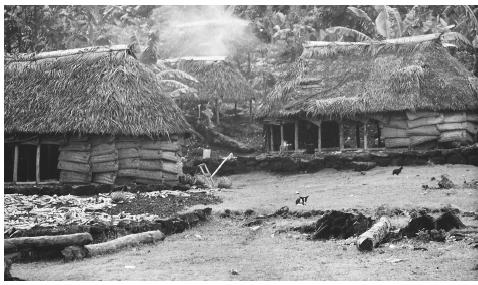
Food and Economy
Food in Daily Life. Staples of the diet remain taro, breadfruit, bananas, coconuts, papayas, mangoes, some chicken, pork, canned corned beef (pisupo) and seafood. Onions, potatoes, lettuce, cabbages, carrots, beans, and tomatoes are also eaten occasionally. Supermarkets carry most foods found in a U.S. market.
In the past, meals were eaten at midmorning and early evening. Food is cooked but may be served cold. Traditionally, most families ate while seated on mats on the floor and many still do. Elders and guests are always served first; children and the women often eat later. With changes in work patterns, three meals daily are now typical.
Most restaurants on Tutuila specialize in American and other foreign foods, but a few offer more traditional Samoan foods.
Food Customs at Ceremonial Occasions. Foods served on ceremonial occasions include daily fare plus whole pigs, potato salad, chop suey, puddings, cakes, and ice cream. Palusami (coconut cream bundled in young taro leaves) has become a treat for special occasions. A great quantity of food is served at special events, with guests being expected to eat a portion and take the rest home to share with their households. Kava , a nonalcoholic, mildly narcotic drink, is served to chiefs on ceremonial occasions.
Basic Economy. In this traditionally agricultural country, only 989 farms ("plantations") produced for family consumption in 1990 and 137 produced crops for sale. Two-thirds of these farms have less than five acres. U. S. currency is used in American Samoa.
Imports include food, fuel, raw materials for manufacturers, building materials, and mechanical equipment. In 1996, $471 million in goods was imported primarily from the United States, with exports of $313 million.
The government employs 30 percent of the workforce, the tuna canneries employ 33 percent; the remaining 37 percent fill service, professional, and laborer positions. About 56 percent of families live below the poverty level.
Land Tenure and Property. With the exception of small amounts of government and church property, most land is owned by Samoans. Traditionally, communal ownership was by 'aiga and was controlled by the matai. This remains true for much land. Some whites married to Samoan women acquired individual ownership of land before the 1930s, when the U. S. Navy outlawed land sales.
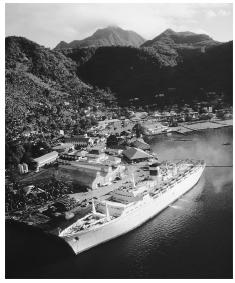
Commercial Activities. Most commerce is based on the sale of imported products. The most common retail trade establishments are places to eat (over 100) and grocery stores (nearly 200), particularly small family-owned general stores.
Major Industries. The largest industry is fish processing and canning, with pet food as a by-product. Canned tuna, shipped to the United States, accounts for 94 percent of exports. There is also a garment industry, whose products represent 4 percent of exports.
Division of Labor. Age is an important determinant of work roles, with young people engaging in strenuous activities while the elderly play a more sedentary, supervisory and educational role. Children have household responsibilities while leadership roles are given to middle-aged or older persons. In the past some people had specialized skills in building traditional boats and houses, fishing, and medicine.
Social Stratification
Classes and Castes. There is no true class system in American Samoa. Chiefs' titles are ranked to some degree based on centuries old traditions. These titles belong to specific families ('aiga), and some are ranked higher and are more respected than others. This is primarily significant ceremonially and determines seating in the fono (village council) and the order in which kava is served, but all have an equal opportunity to speak. Any male can aspire to be a matai, since titles are acquired through a democratic process of election by their aiga .
Political Life
Government. The governor and lieutenant governor are elected by popular vote for a four-year term. There are two legislative bodies: a Senate of eighteen chiefs (matai) , selected by the paramount chiefs of each county, and the House of Representatives, with one member from each of twenty-one legislative districts, chosen by popular vote. American Samoa is represented in the U. S. House of Representatives by a nonvoting delegate. The government is funded in part by local taxes, but the United States provides over 60 percent of funding through grants.
Leadership and Political Officials. Village leadership is the function of the village council (fono), made up of the matai of each household. One becomes a matai through service to the family, knowledge of Samoan customs, and personal qualities such as diplomacy, intelligence, and speaking skills. Higher education, experience dealing with non-Samoans, and economic success may also be important. Political campaigns for higher offices may involve American-style rallies and fund-raising events, and candidates for governor tend to identify with the Democratic and Republican parties.
Social Problems and Control. A police department handles routine law enforcement, and the legal system is similar to that of the United States. An attorney general is responsible for criminal prosecution, environmental enforcement, consumer protection, immigration, land disputes and disputes over chiefly titles. The High Court has nine judges, including the Chief Justice. The most common crimes are disorderly conduct, assault, burglary, driving under the influence of alcohol, and property damage. Sexual offenses and murder are relatively infrequent.
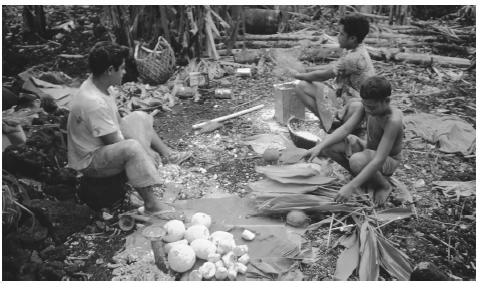
Military Activity. American Samoa has no standing military. The United States maintains a Coast Guard Unit on Tutuila, and sends recruiters for various branches of service to Pago Pago. Samoans can enlist in the military, and it is a popular career option. They leave Samoa for training and service.
Social Welfare and Change Programs
The Department of Human and Social Services administers federally funded programs that include disability services, foster care, child care subsidies and provider training, drug and alcohol counseling, and vocational rehabilitation. The largest programs provide nutritional education and assistance to the elderly and the WIC (Women, Infants and Children) program for low-income women and children up to age five.
Nongovernmental Organizations and Other Associations
Villages often have an organization of chiefs' wives. This "women's committee" entertains important visitors and raises money for causes such as equipping village medical clinics and church schools.
Untitled men in villages are organized into a cooperative work group called the aumaga that has important ceremonial and labor responsibilities. It is called the "strength of the village," and the leader (usually the son of a high-ranking chief), functions ceremonially as the "village prince," the manaia . The aualuma is the organization of unmarried women and widows. It engages in communal labor activities, entertains guests, and its members serve as attendants to the "village ceremonial princess," the taupou .
Gender Roles and Statuses
Division of Labor by Gender. Before the transition to a cash economy, men were responsible for heavy agricultural work, fishing, and house construction. Young men cooked much of the daily food and did the cooking and serving at ceremonial events. Women's activities included sewing, weaving floor and sleeping mats, laundry, child care, and later cooking with modern appliances. Nursing has long been an acceptable role for women. Many of these traditional roles continue today, but new options are important. Men and women now work in tuna canneries, banks, stores, tourist-related businesses, and the school system. Men work in construction, transportation, shipping, and government agencies.
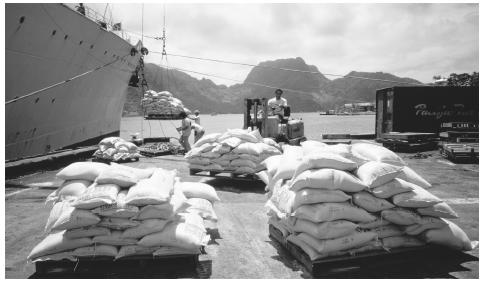
The Relative Status of Women and Men. Historically, Samoa has been a male-dominated society. Women exert a great deal of behind-the-scenes power. Professional and authoritative positions are held mostly by men, but women occupy important roles in some government agencies and businesses and in some cases serve as matai.
Marriage, Family, and Kinship
Marriage. Young people choose their marriage partners, but marriage is primarily an economic alliance between families. In earlier times, high chiefs' sons married high chiefs' daughters, and lower status couples often eloped. One cannot date or marry a blood relative. Nearly everyone marries, usually in the middle to late twenties, and weddings involve elaborate gift exchanges between the two families. Divorce is rare, but remarriage is fairly common among younger people.
Domestic Unit. The household averages seven people and consists of one or more nuclear families and some collateral relatives. It tends to involve three generations and is flexible in composition. The occupants are related through blood, marriage, and adoption. After marriage, couples settle either in the household of the bride or the groom, each of which is headed by a matai. All social and economic activities are under the control of the matai, who is usually a male.
Kin Groups. The largest kin group is the 'aiga, which includes all individuals tracing kinship to a common ancestor. This extended family may have households in different parts of a village or in several villages. The matai of these households exercise various levels of authority within the 'aiga. Matai are members of the village council (fono) which is a regulatory and decision-making body for the community. A matai settles family squabbles and makes decisions about the family's financial contributions to weddings, funerals, and church donations. The entire 'aiga interacts primarily at weddings, funerals, elections and installations of matai, and family emergencies.
Socialization
Infant Care. Infants receive a great deal of affection and attention and are held and carried during the first year of life. The household usually includes a grandmother, who often serves as primary babysitter. Babies are fed when hungry and sleep where and when they doze off.
Child Rearing and Education. Young children are supervised by a grandmother or other women in
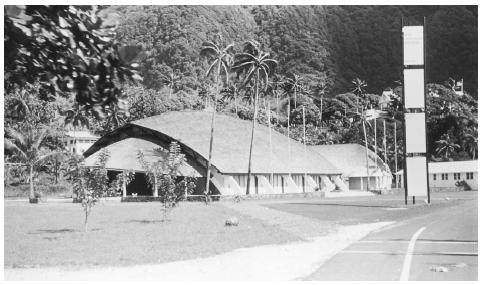
Higher Education. American Samoa Community College on Tutuila offers associate-level degrees. Most students major in liberal arts, teacher education, and business. Some students attend college in the United States. About seven percent of the population age twenty-five and older have a bachelor's or more advanced degree.
Etiquette
Samoans are meticulous about courtesy, particularly toward the elderly and holders of chiefly titles. One does not stand while others are seated, and if one enters a room where others are sitting on the floor, it is proper to bend slightly and say "Tulouna" ("excuse me"). A respect vocabulary is used when speaking to chiefs. Reciprocal courtesy and etiquette are characteristic at ceremonial and political events.
Religion
Religious Beliefs. Before the arrival of missionaries in 1830, Tagaloa was recognized as the creator of the islands and their people and matai served as family religious leaders. The first missionaries represented the London Missionary Society, called LMS by Samoans and still used to identify that denomination. Known today as the Congregational Christian Church of American Samoa, it ministers to fifty percent of the population, while the Catholic Church claims twenty percent and Mormon, Methodist, and Pentecostal churches serve the remaining thirty percent. Samoans are faithful churchgoers and generous supporters of village churches and pastors.
Religious Practitioners. With the exception of the Catholic Church, which usually includes a few Caucasians among its leaders, most denominations have Samoan religious leaders.
Rituals and Holy Places. Church services follow Western rituals, and choral music is an important element. Most villages have at least one church. The dedication of new churches is of supreme importance and involves feasts and choral competitions
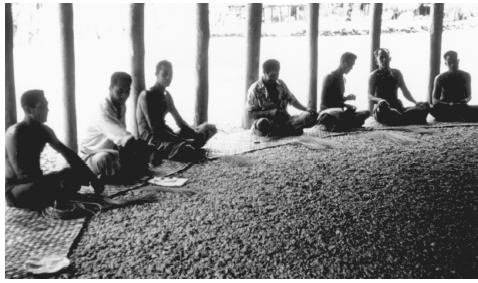
The second Sunday in October is White Sunday, when church services are conducted by children, who sing, recite Bible verses, and present plays. All wear new white clothing. After church the children are served a meal at home featuring special foods.
Death and the Afterlife. Death is viewed as being "God's will." The traditional belief that dying away from home leads to one's spirit causing trouble for survivors persists. Until the 1980s, funerals were the day after death. Developments of mortuary services allows delayed burial to accommodate overseas relatives. Gifts are given to the family, and burial is done on family land.
Medicine and Health Care
American Samoa is a relatively healthy place, but hypertension and obesity are significant health problems in the population. Leading causes of death are heart disease, cancer, and cerebrovascular disease. A hospital on Tutuila provides medical, surgical, obstetric, pediatric, and emergency care. More limited services are available at several small clinics, usually staffed by nurses, in a few outlying villages. Local air service is used to transport seriously ill people from Manua'a. There is limited reliance on traditional healers (bush medicine), particularly for ailments known before European contact.
Secular Celebrations
Flag Day is celebrated on 17 April to commemorate the raising of the American flag over American Samoa in 1900, when the islands became a U.S. territory. Activities include traditional group dancing and singing, speeches, cricket games, and races in long canoes, each with about 50 oarsmen.
The Arts and Humanities
Support for the Arts. The Arts Council and the Government Museum support art instruction for children and adults and subsidize traditional artists to perpetuate traditional arts.
Literature. Oratory is a valued tradition, and a vast body of mythology, legends and poetry survives through use by talking chiefs in village council deliberations and speeches at ceremonial occasions.
Graphic Arts. Samoans value siapo (barkcloth tapestries) and finemats as family property to be
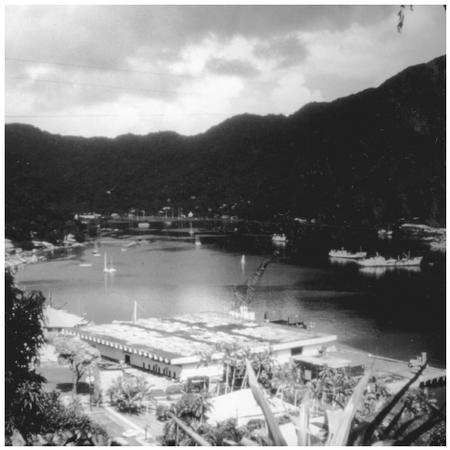
Performance Arts. Group singing and dancing are common art forms. Large dance groups of men or women perform movements in unison with hand claps and body slaps. Solo dances are performed by the village ceremonial princess ( taupou ), sometimes flanked by male support dancers.
Bibliography
American Samoa government. American Samoa Statistical Yearbook, 1996.
Baker, Paul, J. Hanna, and T. Baker. The Changing Samoans, 1986.
Bindon, James R. "Dietary and Social Choices in American Samoa." The World and I, May: 1986, pp.174–185.
—, Amy Knight, and William Dressler. "Social Context and Psychosocial Influences on Blood Pressure among American Samoans." American Journal of Physical Anthropology 103: (May):7–18, 1994.
Cote, James. Adolescent Storm and Stress: An Evaluation of the Mead-Freeman Controversy, 1994.
Gray, J. A. C. Amerika Samoa, 1960.
Holmes, Lowell D. "The Function of Kava in Modern Samoan Culture." In Efron, D. H., ed., Ethnopharmacologic Search For Psychoactive Drugs, 107–118, 1967.
——. "Samoan Oratory." Journal of American Folklore, 82:342–355, 1969.
——. Quest for the Real Samoa: The Mead/Freeman Controversy and Beyond , 1987
—— and Ellen Rhoads Holmes. Samoan Village: Then and Now , 2nd ed., 1992.
Mead, Margaret. Coming of Age in Samoa, 1943.
——. Social Organization of Manu'a, 2nd ed., 1969.
Oliver, Douglas. The Pacific Islands , 3rd ed., 1989.
U.S. Bureau of the Census. Statistical Abstract of the United States, 1998.
Whistler, W. Arthur. Samoan Herbal Medicine, 1996.
—L OWELL D. H OLMES AND E LLEN R HOADS H OLMES
tops or trash or just leaves after harvest?
Any idea
thanks
Pierre
Its great that these information have brought it out to us Samoans so that we could know what to the past.
Surely we know about samoans but not much at all.Thank You reseachers.
The article sounds so tremendous...
The way we live is the way we think...
Im PRouD tuH b A SAMOAN.
R u SAMOAN?lol
gud luck.
Since retirement, I have traveled extensively and most recently worked as a non-medical volunteer for Operation Smile in Cebu City, Republic of the Philippines. I have recently authored a book titled Delia's Promise (available through Lulu.com)in which I describe the culture of the Filipino people through the eyes of a Filipino child.
Tonight I watched a compelling piece about American Samoa on Sixty Minutes. I was concerned that the fishibg and cannery industries are closing and it will possibly create a serious employment and economic void in the Samoan population which already suffers a low family income dilema. Combined with the closing of these industries and a recent tsunami, the country appears to face serious economic, educational and societal issues.
I had a vision tonight. Please understand that I am not a radical zealot in any manner of my life's experience, but I was greatly impressed with the values described on the programming tonight regarding the deep respect young people had for their families and elders and the warmth and devotion of the people presented by the Sixty Minute producers.
My so-called vision included the potential opportunity to parley the high visibility of Samoan college and NFL players and the excitement they produce among American sports fans to bring to Samoa an industry of recognition, support and funding of educational opportunities for Samaon youth.
There are three NFL teams in California: The San Diego Chargers, the San Franscisco Forty-niners and the Oakland Raiders. If those franchises were contacted with the proposition of participating in the funding of schools, playing facilities and equipment for the development of Sasmoan youth,, with the advantage of having these franchises recognized by the Samoan people for their generosity and support of the Samoan people, those franchises very well might become the recognized agencies and organuzations that promote not only the support and develpment for the remarkable athletic talents of the Samoan young men but also recognized for the creation of good physical facilities to support all athletic activities for Samoan youth but also the enhancement of acadimic programs in the public schools of Samoa.
The natural evolution of such a relationship of these NFL franchises and Samoan youth would create a loyalty of the the franchises to recruit the talents of future NFL Samoan football players.
Importing excellent teachers and staff to work in Samoan schools has great potential. I serves as a personnel officer in public schools and I am experienced in the recuiting of teachers and administrators. I am also an avid sports enthusiast and I have received awards and recognition for my work with our students here in California.
It is my intention to visit American Samoa very soon and I would be interested in meeting anyone in the administration who would be willing to meet with me to discuss these ideas. From such dreams and ideas often comes progress and hope. I am not interested in any remuneration for my efforts, just an exciting personal interest in the process of creating a synergistic opportunity which just might result in enhanced opportunities for the young people of American Samoa.
Sincerely
Peter Shaw
I'm heading to Samoa fyi, not American Samoa, is this a huge difference as well?
I'm heading to Samoa fyi, not American Samoa, is this a huge difference as well?
JUST A REQUEST IF YOU CAN PROVIDE SPECIFIC INFORMATION FOR CERTAIN COUNTRIES.
TANKYOU ONCE AGAIN AND HOPE TO MEET SUCH IN MY ASSIGNMENTS REGARDING DIFERENT SUBJACTS AGAIN
Thanks for any help you can give me...
i am doing a asignment on samoa andmy questions are
what aspects of samoan culture has been brought to new zealand
what baspects of samoan culture have been changed in new zealand
and whow has samaon lifestyle changed over the years
THANK YOU